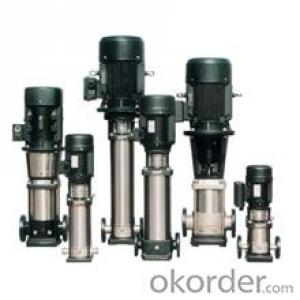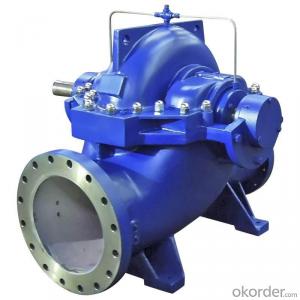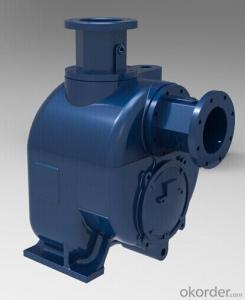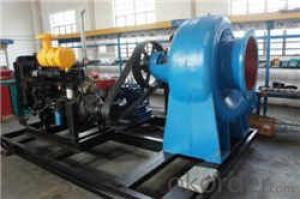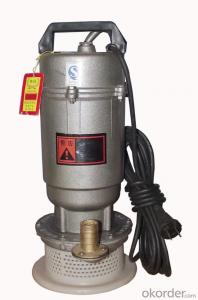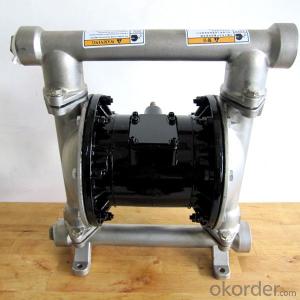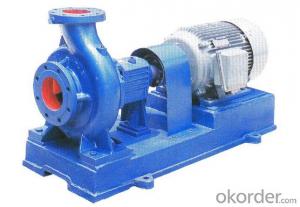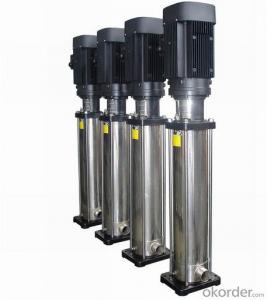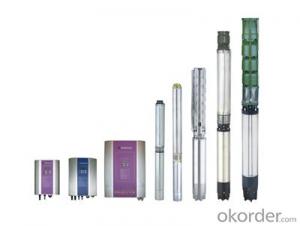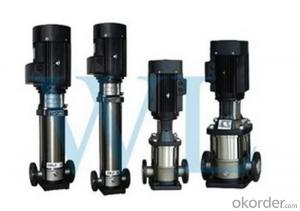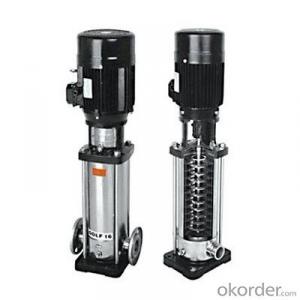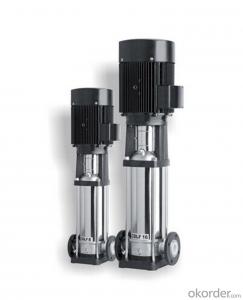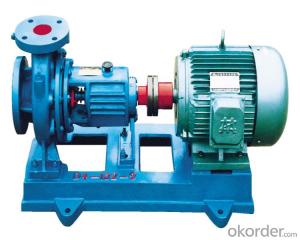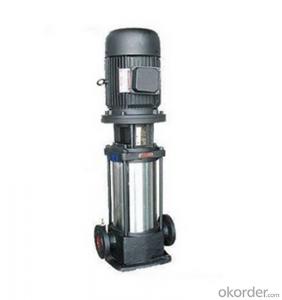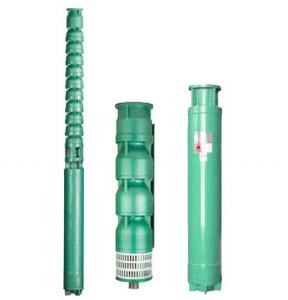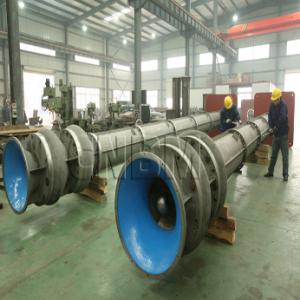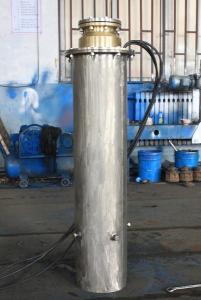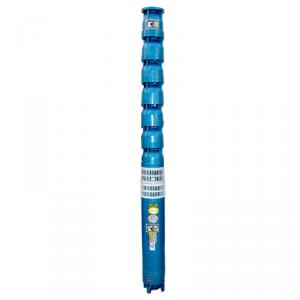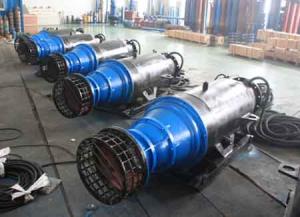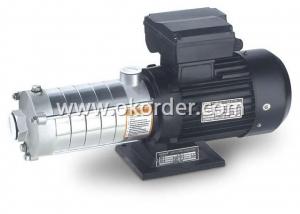Stainless Steel Vertical Multi-stage Centrifugal Pump
- Loading Port:
- China Main Port
- Payment Terms:
- TT OR LC
- Min Order Qty:
- -
- Supply Capability:
- -
OKorder Service Pledge
OKorder Financial Service
You Might Also Like
Application: SMV. SMVN is a kind of non-self-priming vertical multiple-step centrifugal pump. The whole pump is composed of an motor, motor base, pump casing and feet etc. The inlet port and outlet port of the pump are at the same line. All pumps are equipped with free maintenance mechanical seals.
--------------------------------------------------------------------------------
Feature:
--------------------------------------------------------------------------------
OPERATING CONDITIONS
1. Delivery liquid: rarefied, non-inflammable and non-explosive liquid with no solid grain or fiber. Liquid shall not cause any chemical or mechanical damage to pump materials. When the density or viscosity of the delivered liquid is greater than that of water, it is necessary to adopt an electrical motor of correspondingly big power. Whether the pump is applicable for a special liquid or not depends on many factors such as chloride content, PH value, temperature and ingredients of liquid.
2. Liquid temperature: -15oC~103oC
3. Ambient temperature: maximum 40��. When an ambient temperature is over 40oC or the elevation above sea level is over 1000 meters, the cooling effect of the electrical motor will not be good due to the low density of air, and the rated output power of an electrical pump will decrease correspondingly. Therefore, it is necessary to select an electrical motor with higher power.
4. Minimum inlet pressure: the inlet pressure shall be computed in case of following conditions.
High temperature of liquid, flow rate is significantly greater than the rated value, suction lift required for liquid is very big, inlet pipeline is too long; inlet conditions are bad.
5.Motor:squirrel cage induction motors,F Class insulation and in accordance with IP 54.50Hz standard voltage:3Ø/380V.
- Q: I am trying to increase the pressure of my shower and I am looking to install a water pump. Does anyone know what kind of pump would work well for this? I don't want a big pressure pump, just a small one that will be cheap.
- Before you go to the expense of installing a pump to boost pressure, be sure that you don't have a water VOLUME problem. Buy a pressure gauge (about $20) and connect it to your outside hose bib. If your pressure is about 40 psi, then you don't have a pressure problem. If you live in the USA, the Feds (aren't you glad they're looking out for you?) have mandated that no more than 2.5 gallons per minute can flow out a shower head. That's not much volume. So, I would look for a restriction device in the shower head. If the device is part of the shower head, you can't do anything about it specifically. Compare it to a garden hose and a soda straw with 60 psi water pressure. The soda straw won't provide the volume of water that a garden hose would provide. It would seem that the soda straw has less pressure, but it does not. Normal residential water pressure is on the order of 40-60 psi (I have 85 psi). But if new construction continues in my neighborhood, my pressure will decrease because more demand through a fixed size pipe means lower pressure..
- Q: How long would it take before I would see water coming out of the exhaust bellow? I let it run for about 5 seconds or so and shut it of fearing it would burn up. Did this a few times and finally gave up. Pump wasn't hot and impeller was still good. Wondering if I just didn't let it run long enough?
- i've always gone by the 30 second rule. even a NEW or emptied for winter motor that must completely fill, 30 seconds should be long enough. if it hasnt begun pumping by that point, i turn it off and give it some time to cool while i double check everything. then i might give it a full 45 seconds. but it wont overheat in less then a couple of minutes. and if its not pumping with the hose hooked up, the impeller is probably bad already anyways. however, if you do even get it near warm, its already hotter then you think it is where the heat is produced, the cylinders, and where you have tight clearances on fast moving parts, the cylinders and pistons. and if it gets too hot, major damage is quickly done. BTW, service period on a merc impeller is always 100 hours or 3 years. or NOW, before the motor is damaged, if unsure of when it was last done. when the impeller is less then $50 (and about an hour labor, if paying for it) and a new motor is THOUSANDS, you cant replace it too often. dennis, you have NO clue. i suggest getting one before you ruin the motor in your own boat. and in the meantime, keep your bad advice to yourself.
- Q: vw tells me the pump is defective, bad water circulation. i noticed the fans did not turn on when it began to overheat. is that irrelevant with the pump being defective? i even drop the car cold(i started the engine and drove) within 10mins it began to overheat, but the fans did not turn on. is it just the pump? the fan switch is new, no fuses are blown. the radiator and fans are less than 2 yrs old. 2000 jetta
- You should've noticed the worn out tires before u even stepped foot in the car. Go to any tire shop and get new tires, they will balance them when installing the new ones and that will take care of the vibrating. As for the water pump going out, I agree that that shouldn't have happened at 27k
- Q: I've searched the net but cannot find exactly what I'm looking for and hoping someone out there can steer me in the right direction! Maybe I'm not looking in the right place....or do I have to fabricate my own? I'm up for the challenge!1) Trying to source a water pump that I'm going to power by HAND or a BICYCLE. 2) My choice of pump to give a continuous stream of water (very important) is a rotary (centrifugal) type or is there something else capable of a continuous output?3) This will NOT BE USED for potable water. SPECS:a) lightweight but durable, the smaller, the better. b) low RPM, high volume output and capable of producing/handling pressure. c) self-primingd) able to handle some small particulates in the water as I am using rain water. (from outside, NOT filtered, so the following may be present: bugs, dust, etc...) Thank you, in advance, for your help and would be nice to thank the individual(s) for a unique answer to my request at a later date so let me know you're preferred method of contact!
- There are very small rotary water pumps designed to be driven with hand-held electric drills. These pumps may be purchased in some hardware stores or farm supply stores. One could be adapted to a bicycle- type drive. Small pumps have about a 50% efficiency so you would need to produce sustained muscle power applied at around 150-200 watts to achieve 75 -100 watts of effective hydraulics. Applied watts = (GPM) (PSI) / 1.277 million (eff.) Where eff. is as a decimal. Edit : A 3/8 drill will pull about 280 watts. I can do 200 watts on an exercise bike, but not for long. I am a 79 heart patient, so you can probably do better..
- Q: Is there a way to test and see if it is the water pump that causes the car heater to blow hot air one time and then, next time it blows cold air? We flushed the heater core and did other tests, so we do not believe it is the heater core. We left the radiator cap off and ran the car (ford thunderbird..'94) for 20 minutes and watched the antifreeze level come up, but doesn't go down, not circulating. We cannot afford to go to another garage. None of them seem to know what to do anywyas and we keep paying people to fix the heater and it is not fixed. We have put two new thremostats in car, too, figuring that maybe the first one may have been faulty, but should we try that again?
- Note that the main purpose of a water pump in your car is to keep the engine cool. The heat that you get through the heater comes off the smaller hoses on the water pump. If your car isn't overheating chances are the pump is ok. Check your engine temp after the car has ran for awhile. The temp guage should go up when the car is warming up, then the guage will drop when the thermostat opens. It won't drop alot but you should be able to see it. Another thing you can try is to follow the heater hoses to where they go into the firewall and touch them after the car has ran for awhile. If your heater is on full they should both feel about the same temp. There is a control valve on the heater hoses that regulate the flow of water to the heater core and this valve may not be working properly.
- Q: I've noticed after driving my car for a while recently it squeals while accelerating. I'm wondering if its the water pump cause I've had a coolant leak for a while. I poured alluminum sealer in the reservoir and its stopped the leak almost completely though. If it was a broken pump, would this sealer have stopped the leak like it has? I drive a 2000 saturn sl2
- If you have ample room to change a water pump, go for it; however, keep in mind some cars use that belt for timing. If the belt is also a timing belt, take it your branded dealer.
- Q: WHERE IS THE WATER PUMP LOCATED ON A 1995 HONDA CIVIC
- Hello, okorder
- Q: Work done in water pumping?Water is to be brought from a well 60 meters bellow ground level to a tower 10 meters high, once there the water falls freely on a 5000 liter tank. A submerged pump 10 meters under water level and a two inch diameter pipe is to be used. What is the work done by the pump when 2000 liters have been served to the tank; what is the power of a pump selected to do this work in 20 minutes.
- Power_W = (Mass_kg * Gravity_m/s/s * Height_m) / time_s Where: Mass kg is 1kg/l of 2000 liters Gravity is 9.81m/s/s Head is 60m + 10m (height). The suction head is ignored because the pump is submerged. In practice there is some suction head due to intake restrictions like pipes, check valves, strainers. The time is 20 minutes in seconds. The work is the energy used in the time allocated, which is: power * time in seconds, which is watt seconds = joules. Not needed here as it is in the formula above. Power is the rate of doing work. The depth below water is not really relevant except for pipe losses which increase the head slightly. The flow is 2000 liters/20 minutes = 100 l/min. This can be used with the head of 70m to determine the pipe restriction, which amounts to a pressure drop representing extra head added. It will indicate whether the pipe is too small (excessive head added) or whether the pipe is overkill (no head added). You can find on line calculators for this, e.g. search pipe resistance flow on line calculator. I am guessing a 2 inch pipe has little loss at this flow. This is the so called water power. It is the output power of the pump. The pump may only be 50% or so efficient, so the mechanical power delivered by the motor needs to be greater by this ratio. The electrical input power to the motor is greater again to allow for motor efficiency. This might be 60-90%. In practice the efficiency of pump and motor are determined from user manual or specification of the actual devices with the actual loads (head and flow).
- Q: What is the difference between a low pressure pump and a high pressure pump?
- High pressure pump head, large power! High pressure pump, low pressure pump has no strict limit
- Q: could you explain the process by which water is pumped out of the ground for purposed such as drinking water or irrigation? Can you put it in terms a high school senior would understand?
- (1) Identify your potential water source through various methods. (2) Drill a small exploratory hole to different depths, test water pressure and water quality. (3) Drill the complete borehole for production and retrieval of the groundwater. (4) Complete the physical well, will a sheath to allow in the water at the wanted levels, solid pluge to keep other levels out. (5) Insert a chemical and physical filter system (small screen membranes, activate charcoal and diatomaceous earth, etc.) (6) Put in the submersible pump and plug it in. (7) The pump is made up of a motor, an intake and a centrifugal pump. It's all sealed so no water can penetrate through. The water is suctioned into the centrifugal pump, which is an impeller type device. The water is then pushed out at a much higher pressure rate than it came in. This is how the pump works from the bottom instead of above ground. The water is sent to the pressure tank, sometimes referred to as a holding tank, and is kept at a constant pressure, so when you turn on your faucet or shower, the water comes out quickly. As you use the water, more water is pumped into the tank and as the pressure drops in the tank, it will automatically come on and pressurize again.
Send your message to us
Stainless Steel Vertical Multi-stage Centrifugal Pump
- Loading Port:
- China Main Port
- Payment Terms:
- TT OR LC
- Min Order Qty:
- -
- Supply Capability:
- -
OKorder Service Pledge
OKorder Financial Service
Similar products
Hot products
Hot Searches
Related keywords
